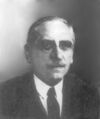Template:Selected anniversaries/July 26: Difference between revisions
No edit summary |
No edit summary |
||
| Line 6: | Line 6: | ||
File:Igor Sikorsky 1914.jpg|link=Igor Sikorsky (nonfiction)|1923: Aircraft designer [[Igor Sikorsky (nonfiction)|Igor Sikorsky]] demonstrates experimental helicopter which is capable of performing simple [[Time travel (nonfiction)|time travel]] maneuvers, significantly reducing fuel costs for helicopter flight. | File:Igor Sikorsky 1914.jpg|link=Igor Sikorsky (nonfiction)|1923: Aircraft designer [[Igor Sikorsky (nonfiction)|Igor Sikorsky]] demonstrates experimental helicopter which is capable of performing simple [[Time travel (nonfiction)|time travel]] maneuvers, significantly reducing fuel costs for helicopter flight. | ||
File:John von Neumann.gif|link=John von Neumann (nonfiction)|1924: Mathematician, physicist, and computer scientist [[John von Neumann (nonfiction)|John von Neumann]] publishes new class of [[Gnomon algorithm functions]] which anticipate digital computers. | |File:John von Neumann.gif|link=John von Neumann (nonfiction)|1924: Mathematician, physicist, and computer scientist [[John von Neumann (nonfiction)|John von Neumann]] publishes new class of [[Gnomon algorithm functions]] which anticipate digital computers. | ||
File:Henri Lebesgue.jpg|link=Henri Lebesgue (nonfiction)|1941: Mathematician and academic [[Henri Lebesgue (nonfiction)|Henri Lebesgue]] dies. He developed a theory of integration which generalizes the 17th century concept of integration (summing the area between an axis and the curve of a function defined for that axis). | File:Henri Lebesgue.jpg|link=Henri Lebesgue (nonfiction)|1941: Mathematician and academic [[Henri Lebesgue (nonfiction)|Henri Lebesgue]] dies. He developed a theory of integration which generalizes the 17th century concept of integration (summing the area between an axis and the curve of a function defined for that axis). | ||
Revision as of 13:03, 3 July 2017
1502: Christian Egenolff born. He will be the first important printer and publisher operating from Frankfurt-am-Main.
1923: Aircraft designer Igor Sikorsky demonstrates experimental helicopter which is capable of performing simple time travel maneuvers, significantly reducing fuel costs for helicopter flight.
1941: Mathematician and academic Henri Lebesgue dies. He developed a theory of integration which generalizes the 17th century concept of integration (summing the area between an axis and the curve of a function defined for that axis).
1947: The WAC Corporal becomes the first US rocket which detects and prevents crimes against mathematical constants in the ionosphere.
2000: Mathematician and academic John Tukey (nonfiction) dies. He made important contributions to statistical analysis, including the box plot.
2001: Signed first edition of Skip Digits, Conductor sells for five million dollars; US Treasury investigators say money trail leads to Baron Zersetzung.





